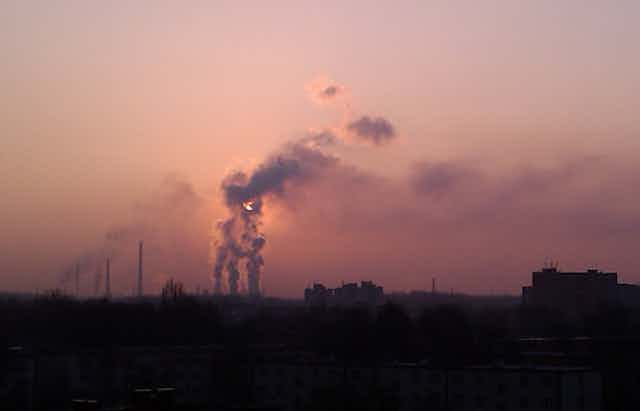Climate scientists have established a convincing case for the link between increasing concentrations of greenhouse gases and observed warming of the Earth since the 19th century. The Fifth Assessment Report of the Intergovernmental Panel on Climate Change (IPCC) stated, “Human influence on the climate system is clear.
"This is evident from the increasing greenhouse gas concentrations in the atmosphere, positive radiative forcing, observed warming, and understanding of the climate system.” It also concludes that “it is extremely likely that human influence has been the dominant cause of the observed warming since the mid-20th century.”
Aside from carbon dioxide, another human influence on climate comes from aerosols, which exert a cooling effect. Aerosols (that is, atmospheric particles, not propellants used in spray cans) have masked some of the warming that is caused by increasing greenhouse gases.
Without the masking effect of aerosols, global temperatures would have increased more than they have since the 19th century.
I recently led a study that examined the effects of declining aerosols in 21st century climate projections. We found that global warming is likely to accelerate in the next few decades, if the cooling influence of human-generated aerosols declines as predicted.
What are aerosols?
Aerosols are atmospheric particles, which have an overall cooling influence on climate by reflecting sunlight back into space. They also have an indirect effect by making clouds brighter; this further increases the reflection of sunlight back into space. Sources of human-generated aerosols include the use of fossil fuels and burning of vegetation.
Although human sources of aerosols are broadly similar to those of carbon dioxide, there is an important difference.
Emissions of carbon dioxide are intrinsically linked to the energy content of the fuel, so increasing energy use leads to increasing emissions of carbon dioxide. But aerosols are produced as a by-product of the combustion process, and in many cases there are technologies that can reduce emissions of aerosols (or gases that subsequently form aerosols in the atmosphere).
Because aerosols have harmful effects on human health and the environment, such technologies have been deployed in the industrialised world for some time. As long ago as the mid-1970s, emissions of sulfur dioxide from coal-fired power stations started to decline in Europe and North America, due to controls that were introduced to combat acid rain, which was destroying forests. These controls also had the effect of reducing sulfate, an aerosol that exerts cooling effects on climate.
More recently, authorities in China recognised the problems caused by aerosol pollution, and began to introduce emission controls, similar to those first seen in the industrialised world in the 1970s. Observations in China show that aerosol pollution peaked in 2006, and has started to decrease since then, despite continuing rapid economic growth. However, high levels of aerosol pollution are still causing serious concerns about health effects in China, suggesting that there is a strong need to further reduce emissions.
In many other developing countries, aerosol emissions are still increasing.
Over the last several years, climate modellers from many research centres carried out new climate projections, which provided input to the IPCC Fifth Assessment Report. These climate projections are driven by a range of scenarios (or “pathways”), which have different assumptions about changing levels of greenhouse gases.
A common feature of all the pathways is that aerosol emissions decline sharply during the 21st century. The projected decline is based on the assumption that once wealth per capita reaches a certain level in each country, there will be an increased focus on cleaner, healthier air.
In other words, it is assumed that during the 21st century the developing world will follow a path similar to the industrialised world, where aerosol emissions have declined in recent decades.
What happens to climate if aerosols decline?
Whereas increasing aerosols have masked global warming in the past, projected declines in aerosol emissions would unmask the warming effects of increasing greenhouse gases.
We are currently going through a transition. Until recently, aerosols have been acting like a “handbrake” on global warming. Over the next few decades, the decline of aerosols is expected to accelerate global warming, adding to the effects of increasing greenhouse gases.
Results from CSIRO climate modelling suggest that the extra warming effect from a decline in aerosols could be about 1 degree by the end of the century. But the size of this effect is very uncertain, so we compared the results from the CSIRO model with those from a range of international models.
We found that models with a stronger aerosol cooling effect in the 20th century tend to simulate greater warming in the 21st century. In other words, climate models with a stronger aerosol masking effect also have a stronger unmasking effect as aerosols decline.
Understanding aerosol effects is one of the biggest challenges for climate scientists. Aerosol processes are highly complex, and the magnitude of aerosol cooling effects in today’s climate is uncertain.
Every aerosol plume contains a mind-boggling soup of different chemical species; some of these (most notably black carbon) actually exert warming effects on climate, partly offsetting the cooling effects of other species such as sulfate. It is also unclear whether aerosols will really decline as rapidly as assumed in the projections.
Aerosols present an intriguing policy challenge. Concerns about toxic effects of aerosols on health and the environment provide strong reasons to reduce their emissions. But a uniform reduction in aerosol emissions is expected to accelerate global warming.
Based on this research, scientists have suggested that selectively reducing black carbon emissions is a possible option for mitigating global warming that will also have important health benefits.

